Systems Advocacy: Addressing Eating Disorders in the Media
VerifiedAdded on 2023/06/13
|7
|1676
|388
Discussion Board Post
AI Summary
This discussion forum post delves into the critical issue of eating disorders, highlighting the need for systems advocacy to address the problem effectively. It begins by outlining the desired changes, including the development of policies and legislation to raise awareness about eating disorders, their symptoms, implications, and management. The post critically examines how eating disorders are portrayed in the media, noting biases and skewed representations that can misinform the public. It also explores how a systems advocacy approach can be implemented to drive change, emphasizing the importance of community resources, health education, and government support to ensure early detection, proper treatment, and improved healthcare outcomes for individuals affected by eating disorders. The discussion emphasizes the role of psychotherapy, self-help, nutritional management, family approaches, and medication in treating eating disorders.
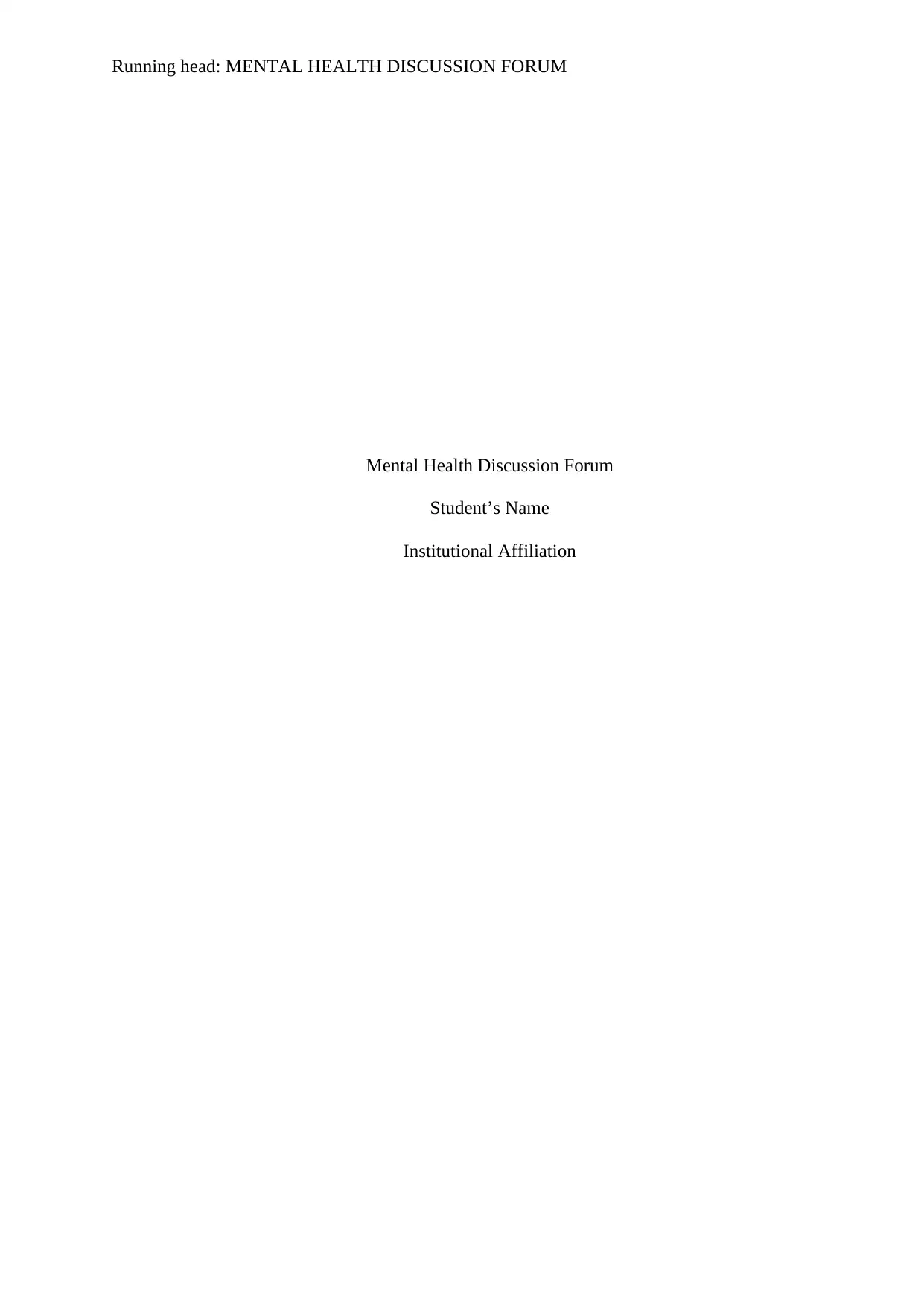
Running head: MENTAL HEALTH DISCUSSION FORUM
Mental Health Discussion Forum
Student’s Name
Institutional Affiliation
Mental Health Discussion Forum
Student’s Name
Institutional Affiliation
Paraphrase This Document
Need a fresh take? Get an instant paraphrase of this document with our AI Paraphraser
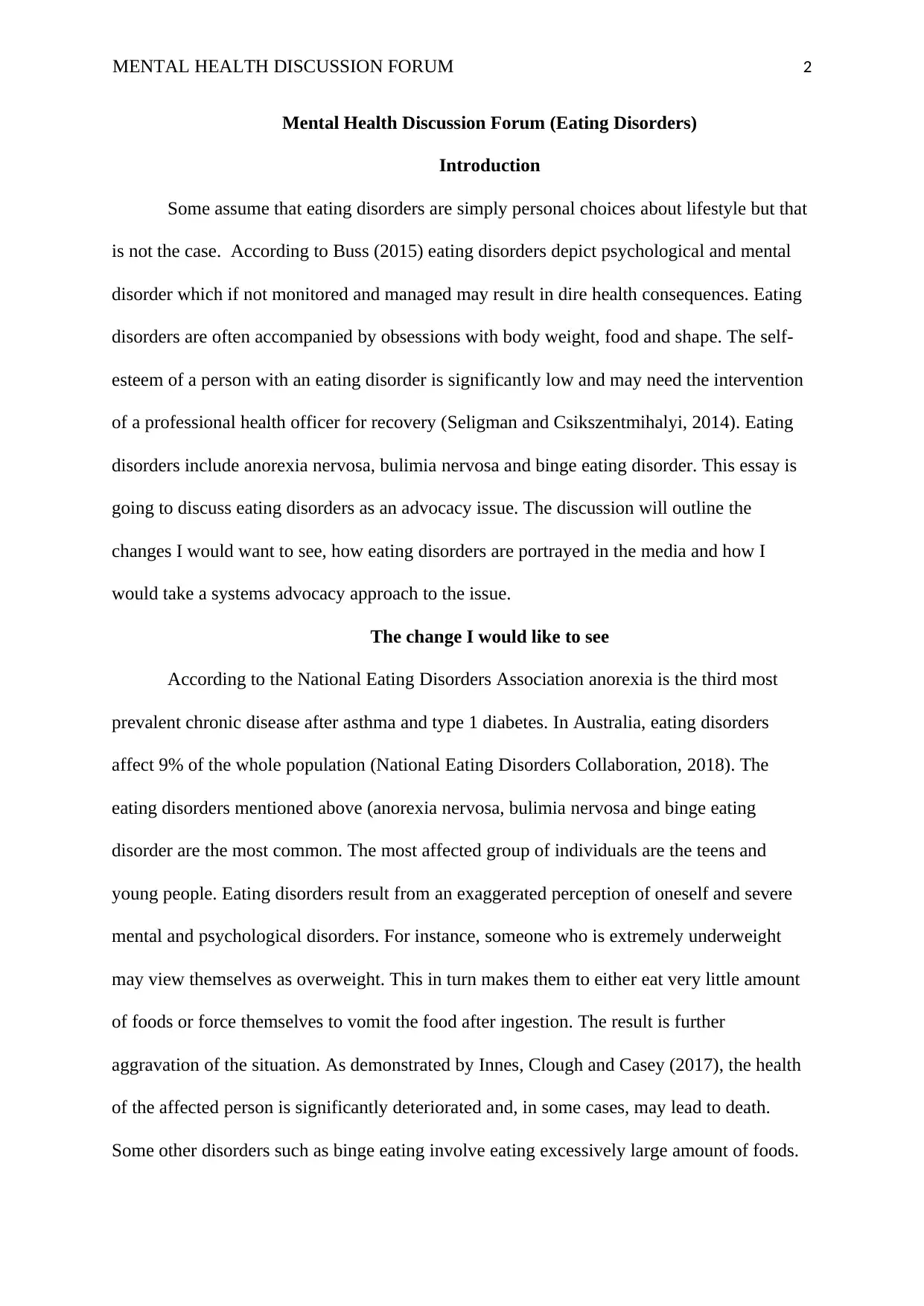
MENTAL HEALTH DISCUSSION FORUM 2
Mental Health Discussion Forum (Eating Disorders)
Introduction
Some assume that eating disorders are simply personal choices about lifestyle but that
is not the case. According to Buss (2015) eating disorders depict psychological and mental
disorder which if not monitored and managed may result in dire health consequences. Eating
disorders are often accompanied by obsessions with body weight, food and shape. The self-
esteem of a person with an eating disorder is significantly low and may need the intervention
of a professional health officer for recovery (Seligman and Csikszentmihalyi, 2014). Eating
disorders include anorexia nervosa, bulimia nervosa and binge eating disorder. This essay is
going to discuss eating disorders as an advocacy issue. The discussion will outline the
changes I would want to see, how eating disorders are portrayed in the media and how I
would take a systems advocacy approach to the issue.
The change I would like to see
According to the National Eating Disorders Association anorexia is the third most
prevalent chronic disease after asthma and type 1 diabetes. In Australia, eating disorders
affect 9% of the whole population (National Eating Disorders Collaboration, 2018). The
eating disorders mentioned above (anorexia nervosa, bulimia nervosa and binge eating
disorder are the most common. The most affected group of individuals are the teens and
young people. Eating disorders result from an exaggerated perception of oneself and severe
mental and psychological disorders. For instance, someone who is extremely underweight
may view themselves as overweight. This in turn makes them to either eat very little amount
of foods or force themselves to vomit the food after ingestion. The result is further
aggravation of the situation. As demonstrated by Innes, Clough and Casey (2017), the health
of the affected person is significantly deteriorated and, in some cases, may lead to death.
Some other disorders such as binge eating involve eating excessively large amount of foods.
Mental Health Discussion Forum (Eating Disorders)
Introduction
Some assume that eating disorders are simply personal choices about lifestyle but that
is not the case. According to Buss (2015) eating disorders depict psychological and mental
disorder which if not monitored and managed may result in dire health consequences. Eating
disorders are often accompanied by obsessions with body weight, food and shape. The self-
esteem of a person with an eating disorder is significantly low and may need the intervention
of a professional health officer for recovery (Seligman and Csikszentmihalyi, 2014). Eating
disorders include anorexia nervosa, bulimia nervosa and binge eating disorder. This essay is
going to discuss eating disorders as an advocacy issue. The discussion will outline the
changes I would want to see, how eating disorders are portrayed in the media and how I
would take a systems advocacy approach to the issue.
The change I would like to see
According to the National Eating Disorders Association anorexia is the third most
prevalent chronic disease after asthma and type 1 diabetes. In Australia, eating disorders
affect 9% of the whole population (National Eating Disorders Collaboration, 2018). The
eating disorders mentioned above (anorexia nervosa, bulimia nervosa and binge eating
disorder are the most common. The most affected group of individuals are the teens and
young people. Eating disorders result from an exaggerated perception of oneself and severe
mental and psychological disorders. For instance, someone who is extremely underweight
may view themselves as overweight. This in turn makes them to either eat very little amount
of foods or force themselves to vomit the food after ingestion. The result is further
aggravation of the situation. As demonstrated by Innes, Clough and Casey (2017), the health
of the affected person is significantly deteriorated and, in some cases, may lead to death.
Some other disorders such as binge eating involve eating excessively large amount of foods.
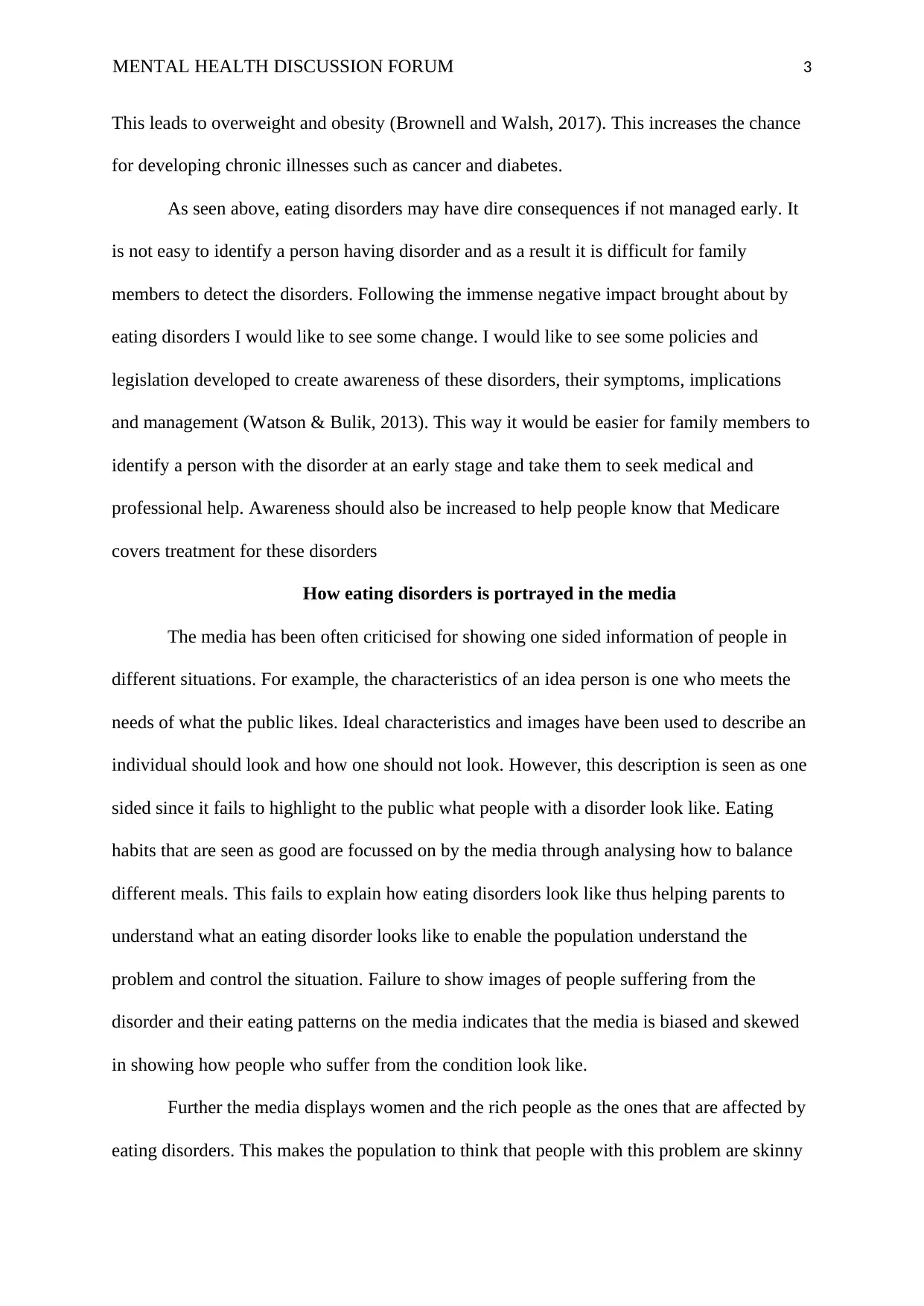
MENTAL HEALTH DISCUSSION FORUM 3
This leads to overweight and obesity (Brownell and Walsh, 2017). This increases the chance
for developing chronic illnesses such as cancer and diabetes.
As seen above, eating disorders may have dire consequences if not managed early. It
is not easy to identify a person having disorder and as a result it is difficult for family
members to detect the disorders. Following the immense negative impact brought about by
eating disorders I would like to see some change. I would like to see some policies and
legislation developed to create awareness of these disorders, their symptoms, implications
and management (Watson & Bulik, 2013). This way it would be easier for family members to
identify a person with the disorder at an early stage and take them to seek medical and
professional help. Awareness should also be increased to help people know that Medicare
covers treatment for these disorders
How eating disorders is portrayed in the media
The media has been often criticised for showing one sided information of people in
different situations. For example, the characteristics of an idea person is one who meets the
needs of what the public likes. Ideal characteristics and images have been used to describe an
individual should look and how one should not look. However, this description is seen as one
sided since it fails to highlight to the public what people with a disorder look like. Eating
habits that are seen as good are focussed on by the media through analysing how to balance
different meals. This fails to explain how eating disorders look like thus helping parents to
understand what an eating disorder looks like to enable the population understand the
problem and control the situation. Failure to show images of people suffering from the
disorder and their eating patterns on the media indicates that the media is biased and skewed
in showing how people who suffer from the condition look like.
Further the media displays women and the rich people as the ones that are affected by
eating disorders. This makes the population to think that people with this problem are skinny
This leads to overweight and obesity (Brownell and Walsh, 2017). This increases the chance
for developing chronic illnesses such as cancer and diabetes.
As seen above, eating disorders may have dire consequences if not managed early. It
is not easy to identify a person having disorder and as a result it is difficult for family
members to detect the disorders. Following the immense negative impact brought about by
eating disorders I would like to see some change. I would like to see some policies and
legislation developed to create awareness of these disorders, their symptoms, implications
and management (Watson & Bulik, 2013). This way it would be easier for family members to
identify a person with the disorder at an early stage and take them to seek medical and
professional help. Awareness should also be increased to help people know that Medicare
covers treatment for these disorders
How eating disorders is portrayed in the media
The media has been often criticised for showing one sided information of people in
different situations. For example, the characteristics of an idea person is one who meets the
needs of what the public likes. Ideal characteristics and images have been used to describe an
individual should look and how one should not look. However, this description is seen as one
sided since it fails to highlight to the public what people with a disorder look like. Eating
habits that are seen as good are focussed on by the media through analysing how to balance
different meals. This fails to explain how eating disorders look like thus helping parents to
understand what an eating disorder looks like to enable the population understand the
problem and control the situation. Failure to show images of people suffering from the
disorder and their eating patterns on the media indicates that the media is biased and skewed
in showing how people who suffer from the condition look like.
Further the media displays women and the rich people as the ones that are affected by
eating disorders. This makes the population to think that people with this problem are skinny
⊘ This is a preview!⊘
Do you want full access?
Subscribe today to unlock all pages.

Trusted by 1+ million students worldwide
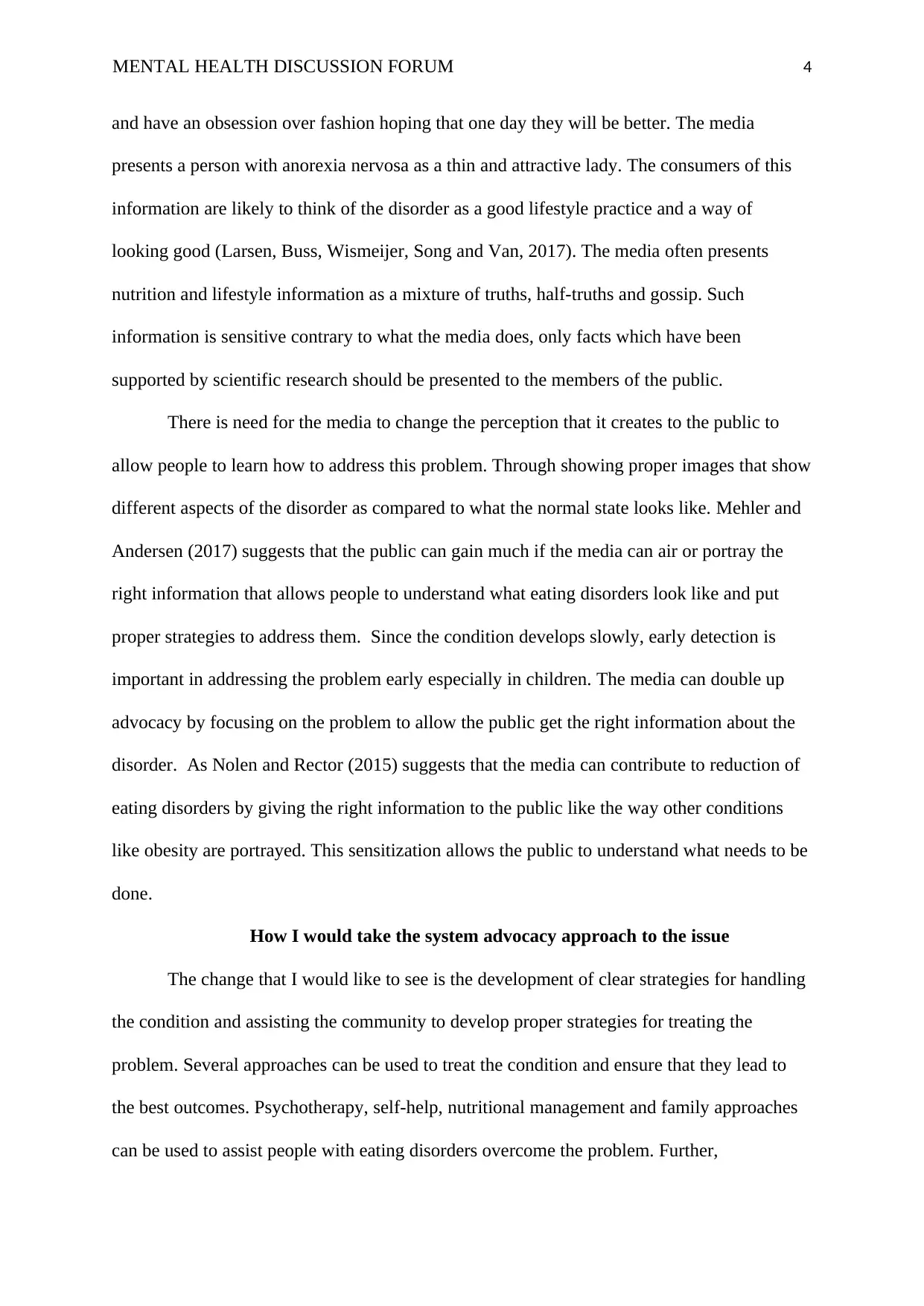
MENTAL HEALTH DISCUSSION FORUM 4
and have an obsession over fashion hoping that one day they will be better. The media
presents a person with anorexia nervosa as a thin and attractive lady. The consumers of this
information are likely to think of the disorder as a good lifestyle practice and a way of
looking good (Larsen, Buss, Wismeijer, Song and Van, 2017). The media often presents
nutrition and lifestyle information as a mixture of truths, half-truths and gossip. Such
information is sensitive contrary to what the media does, only facts which have been
supported by scientific research should be presented to the members of the public.
There is need for the media to change the perception that it creates to the public to
allow people to learn how to address this problem. Through showing proper images that show
different aspects of the disorder as compared to what the normal state looks like. Mehler and
Andersen (2017) suggests that the public can gain much if the media can air or portray the
right information that allows people to understand what eating disorders look like and put
proper strategies to address them. Since the condition develops slowly, early detection is
important in addressing the problem early especially in children. The media can double up
advocacy by focusing on the problem to allow the public get the right information about the
disorder. As Nolen and Rector (2015) suggests that the media can contribute to reduction of
eating disorders by giving the right information to the public like the way other conditions
like obesity are portrayed. This sensitization allows the public to understand what needs to be
done.
How I would take the system advocacy approach to the issue
The change that I would like to see is the development of clear strategies for handling
the condition and assisting the community to develop proper strategies for treating the
problem. Several approaches can be used to treat the condition and ensure that they lead to
the best outcomes. Psychotherapy, self-help, nutritional management and family approaches
can be used to assist people with eating disorders overcome the problem. Further,
and have an obsession over fashion hoping that one day they will be better. The media
presents a person with anorexia nervosa as a thin and attractive lady. The consumers of this
information are likely to think of the disorder as a good lifestyle practice and a way of
looking good (Larsen, Buss, Wismeijer, Song and Van, 2017). The media often presents
nutrition and lifestyle information as a mixture of truths, half-truths and gossip. Such
information is sensitive contrary to what the media does, only facts which have been
supported by scientific research should be presented to the members of the public.
There is need for the media to change the perception that it creates to the public to
allow people to learn how to address this problem. Through showing proper images that show
different aspects of the disorder as compared to what the normal state looks like. Mehler and
Andersen (2017) suggests that the public can gain much if the media can air or portray the
right information that allows people to understand what eating disorders look like and put
proper strategies to address them. Since the condition develops slowly, early detection is
important in addressing the problem early especially in children. The media can double up
advocacy by focusing on the problem to allow the public get the right information about the
disorder. As Nolen and Rector (2015) suggests that the media can contribute to reduction of
eating disorders by giving the right information to the public like the way other conditions
like obesity are portrayed. This sensitization allows the public to understand what needs to be
done.
How I would take the system advocacy approach to the issue
The change that I would like to see is the development of clear strategies for handling
the condition and assisting the community to develop proper strategies for treating the
problem. Several approaches can be used to treat the condition and ensure that they lead to
the best outcomes. Psychotherapy, self-help, nutritional management and family approaches
can be used to assist people with eating disorders overcome the problem. Further,
Paraphrase This Document
Need a fresh take? Get an instant paraphrase of this document with our AI Paraphraser
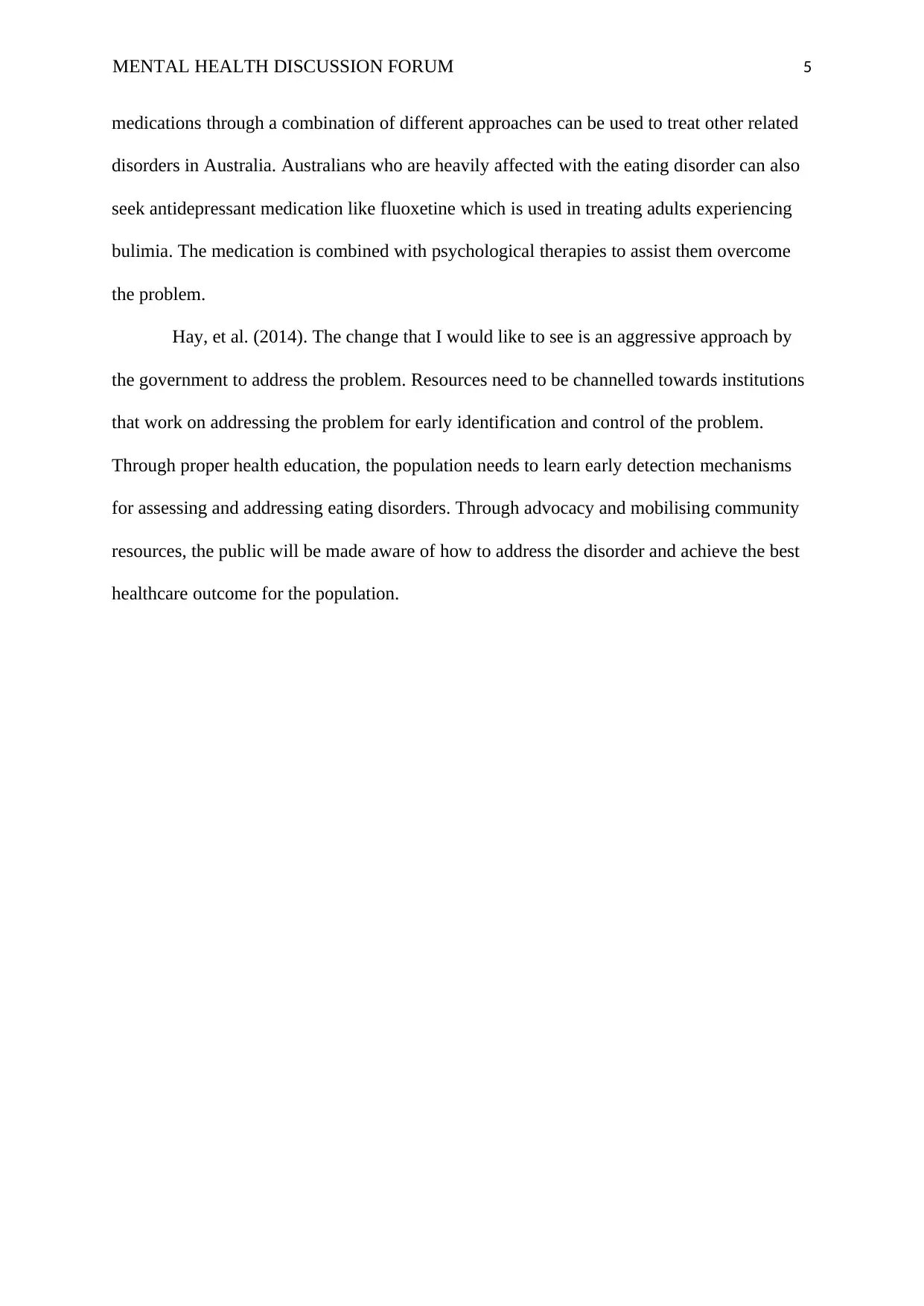
MENTAL HEALTH DISCUSSION FORUM 5
medications through a combination of different approaches can be used to treat other related
disorders in Australia. Australians who are heavily affected with the eating disorder can also
seek antidepressant medication like fluoxetine which is used in treating adults experiencing
bulimia. The medication is combined with psychological therapies to assist them overcome
the problem.
Hay, et al. (2014). The change that I would like to see is an aggressive approach by
the government to address the problem. Resources need to be channelled towards institutions
that work on addressing the problem for early identification and control of the problem.
Through proper health education, the population needs to learn early detection mechanisms
for assessing and addressing eating disorders. Through advocacy and mobilising community
resources, the public will be made aware of how to address the disorder and achieve the best
healthcare outcome for the population.
medications through a combination of different approaches can be used to treat other related
disorders in Australia. Australians who are heavily affected with the eating disorder can also
seek antidepressant medication like fluoxetine which is used in treating adults experiencing
bulimia. The medication is combined with psychological therapies to assist them overcome
the problem.
Hay, et al. (2014). The change that I would like to see is an aggressive approach by
the government to address the problem. Resources need to be channelled towards institutions
that work on addressing the problem for early identification and control of the problem.
Through proper health education, the population needs to learn early detection mechanisms
for assessing and addressing eating disorders. Through advocacy and mobilising community
resources, the public will be made aware of how to address the disorder and achieve the best
healthcare outcome for the population.
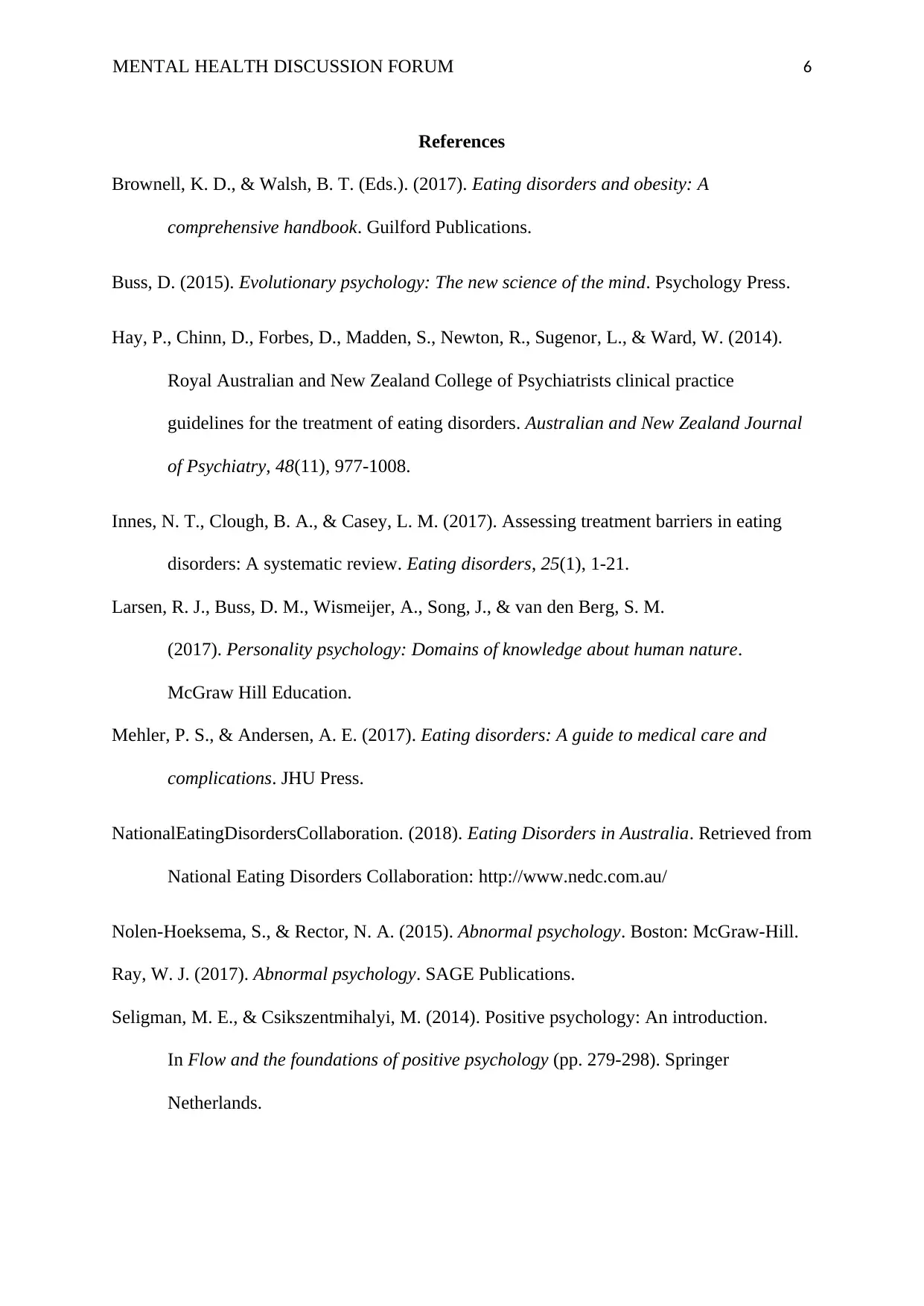
MENTAL HEALTH DISCUSSION FORUM 6
References
Brownell, K. D., & Walsh, B. T. (Eds.). (2017). Eating disorders and obesity: A
comprehensive handbook. Guilford Publications.
Buss, D. (2015). Evolutionary psychology: The new science of the mind. Psychology Press.
Hay, P., Chinn, D., Forbes, D., Madden, S., Newton, R., Sugenor, L., & Ward, W. (2014).
Royal Australian and New Zealand College of Psychiatrists clinical practice
guidelines for the treatment of eating disorders. Australian and New Zealand Journal
of Psychiatry, 48(11), 977-1008.
Innes, N. T., Clough, B. A., & Casey, L. M. (2017). Assessing treatment barriers in eating
disorders: A systematic review. Eating disorders, 25(1), 1-21.
Larsen, R. J., Buss, D. M., Wismeijer, A., Song, J., & van den Berg, S. M.
(2017). Personality psychology: Domains of knowledge about human nature.
McGraw Hill Education.
Mehler, P. S., & Andersen, A. E. (2017). Eating disorders: A guide to medical care and
complications. JHU Press.
NationalEatingDisordersCollaboration. (2018). Eating Disorders in Australia. Retrieved from
National Eating Disorders Collaboration: http://www.nedc.com.au/
Nolen-Hoeksema, S., & Rector, N. A. (2015). Abnormal psychology. Boston: McGraw-Hill.
Ray, W. J. (2017). Abnormal psychology. SAGE Publications.
Seligman, M. E., & Csikszentmihalyi, M. (2014). Positive psychology: An introduction.
In Flow and the foundations of positive psychology (pp. 279-298). Springer
Netherlands.
References
Brownell, K. D., & Walsh, B. T. (Eds.). (2017). Eating disorders and obesity: A
comprehensive handbook. Guilford Publications.
Buss, D. (2015). Evolutionary psychology: The new science of the mind. Psychology Press.
Hay, P., Chinn, D., Forbes, D., Madden, S., Newton, R., Sugenor, L., & Ward, W. (2014).
Royal Australian and New Zealand College of Psychiatrists clinical practice
guidelines for the treatment of eating disorders. Australian and New Zealand Journal
of Psychiatry, 48(11), 977-1008.
Innes, N. T., Clough, B. A., & Casey, L. M. (2017). Assessing treatment barriers in eating
disorders: A systematic review. Eating disorders, 25(1), 1-21.
Larsen, R. J., Buss, D. M., Wismeijer, A., Song, J., & van den Berg, S. M.
(2017). Personality psychology: Domains of knowledge about human nature.
McGraw Hill Education.
Mehler, P. S., & Andersen, A. E. (2017). Eating disorders: A guide to medical care and
complications. JHU Press.
NationalEatingDisordersCollaboration. (2018). Eating Disorders in Australia. Retrieved from
National Eating Disorders Collaboration: http://www.nedc.com.au/
Nolen-Hoeksema, S., & Rector, N. A. (2015). Abnormal psychology. Boston: McGraw-Hill.
Ray, W. J. (2017). Abnormal psychology. SAGE Publications.
Seligman, M. E., & Csikszentmihalyi, M. (2014). Positive psychology: An introduction.
In Flow and the foundations of positive psychology (pp. 279-298). Springer
Netherlands.
⊘ This is a preview!⊘
Do you want full access?
Subscribe today to unlock all pages.

Trusted by 1+ million students worldwide

MENTAL HEALTH DISCUSSION FORUM 7
Watson, H. J., & Bulik, C. M. (2013). Update on the treatment of anorexia nervosa: review of
clinical trials, practice guidelines and emerging interventions. Psychological
Medicine, 43(12), 2477-2500.
Watson, H. J., & Bulik, C. M. (2013). Update on the treatment of anorexia nervosa: review of
clinical trials, practice guidelines and emerging interventions. Psychological
Medicine, 43(12), 2477-2500.
1 out of 7
Related Documents
Your All-in-One AI-Powered Toolkit for Academic Success.
+13062052269
info@desklib.com
Available 24*7 on WhatsApp / Email
![[object Object]](/_next/static/media/star-bottom.7253800d.svg)
Unlock your academic potential
Copyright © 2020–2025 A2Z Services. All Rights Reserved. Developed and managed by ZUCOL.





